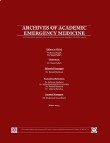Predictive Factors of Suicide Attempt and Non-Suicidal Self-Harm in Emergency Department
Author(s):
Abstract:
Introduction
Suicide is the third cause of mortality in America, second leading cause of death in developed countries, and one of the major health problems. Self-harm is self-inflicted damage to one’s self with or without suicidal intent. In the present study, the predictive factors of suicide attempt and non-suicidal self-harm were evaluated in patients referred to emergency department (ED) with these problem. Methods
The total number of 45 patients with suicide attempt or self-harm admitted to ED were included. Clinical symptoms, thoughts and behaviors of suicidal, and non-suicidal self-harm in these patients were evaluated at baseline. Suicidality, suicidal intent and ideation, non-suicidal self-injury, social withdrawal, disruptive behavior, and poor family functions were evaluated at admission time. Brief clinical visits were scheduled for the twelfth weeks. In the twelfth week, patients returned for their final visit to determine their maintenance treatment. Finally data were analyzed using chi-squared and multiple logistic regression. Results
Forty five patients were included in the study (56.1% female). The mean age of patients was 23.3±10.2 years (range: 15-75; 33.3% married). Significant association of suicide and self-injury was presented at the baseline and in the month before attempting (p=0.001). The most important predictive factors of suicide and self-harm based on univariate analysis were depression (suicidal and non-suicidal items of Hamilton depression rating scale), anxiety, hopelessness, younger age, history of non-suicidal self-harm and female gender (p<0.05). The participants’ quality of life analysis showed a significant higher quality in physical component summary (p=0.002), mental component summary (p=0.001), and general health (p=0.001) at follow up period. Conclusion
At the time of admission in ED, suicide attempt and non-suicidal self-harm are subsequent clinical markers for the patient attempting suicide again. The most independent predictive factors of suicide attempt and self-harm were poor family function, hopelessness, non-suicidality items of Hamilton depression rating scale, history of non-suicidal self-harm, and anxiety disorders.Keywords:
Language:
English
Published:
Archives of Academic Emergency Medicine, Volume:2 Issue: 4, 2014
Pages:
166 to 169
magiran.com/p1312268
دانلود و مطالعه متن این مقاله با یکی از روشهای زیر امکان پذیر است:
اشتراک شخصی
با عضویت و پرداخت آنلاین حق اشتراک یکساله به مبلغ 1,390,000ريال میتوانید 70 عنوان مطلب دانلود کنید!
اشتراک سازمانی
به کتابخانه دانشگاه یا محل کار خود پیشنهاد کنید تا اشتراک سازمانی این پایگاه را برای دسترسی نامحدود همه کاربران به متن مطالب تهیه نمایند!
توجه!
- حق عضویت دریافتی صرف حمایت از نشریات عضو و نگهداری، تکمیل و توسعه مگیران میشود.
- پرداخت حق اشتراک و دانلود مقالات اجازه بازنشر آن در سایر رسانههای چاپی و دیجیتال را به کاربر نمیدهد.
In order to view content subscription is required
Personal subscription
Subscribe magiran.com for 70 € euros via PayPal and download 70 articles during a year.
Organization subscription
Please contact us to subscribe your university or library for unlimited access!


